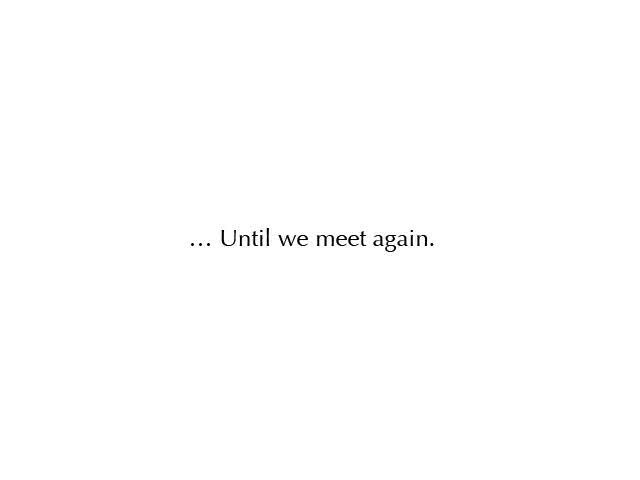Until We Meet Again is the official English-language translation of a freeware Japanese visual novel called Sore Jaa, Mata ne (also called Soremata). The original Soremata was first published in Japan on June 29, 2005. The English translation was published just over two months later on September 6, 2005. Until We Meet Again was one of Insani’s submissions to the 2005 al|together visual novel translation festival. Below, I will review Until We Meet Again as part of my ongoing project to review nearly 30 visual novels that were translated as part of the 2005, 2006, and 2008 al|together translation festivals.
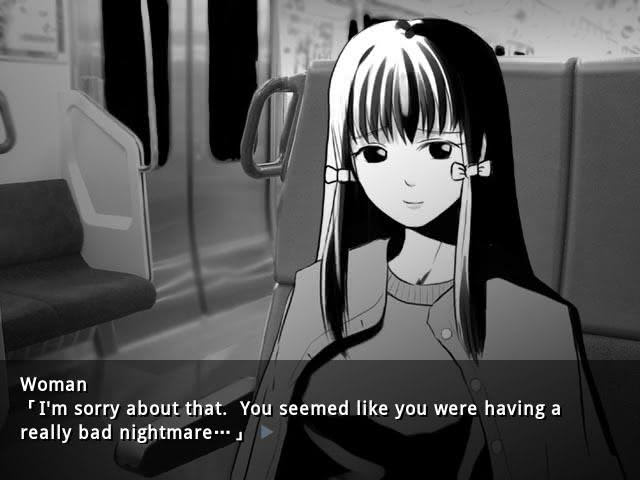
You can learn more about my al|together project by reading my project introduction article. That article includes a running list of our completed al|together reviews. I have a dedicated collection post with links to all of our al|together articles, including reviews, essays, and short posts.
Until We Meet Again features a protagonist on an empty train. He wakes up not knowing why he is on the train or where the train is going. The protagonist meets two people – an adult woman and a middle school student – and gradually learns the nature of his train ride. Until We Meet Again, which takes about 25-30 minutes to read, is one of the most aesthetic and visually creative of all of the al|together translations. Note that my review will not spoil the story, making it safe for people who may be interested in reading it.
Until We Meet Again Details
English Release
| Title | Until We Meet Again |
| Translator | Seung Park |
| Release Date | September 6, 2005 |
| Engine | KiriKiri |
| Official Website | altogether 2005; Insani |
| Visual Novel Database | VNDB Link |
Japanese Release
| Title | Sore Jaa, Mata ne. |
| Developer | Luna Bless |
| Release Date | June 29, 2005 |
| Engine | KiriKiri |
Downloading and Running Until We Meet Again
Until We Meet Again is officially available as a torrent download for Windows:
I re-downloaded the torrent to check its status and found that it downloaded quickly. I am also seeding the torrent periodically to help make it more accessible. I will post an update if I find any direct download links. However, it is an easy torrent to acquire as of December 7, 2022.
Running Until We Meet Again
Running Until We Meet Again is a little bit tricky compared to most of the al|together translations. While most of the al|together visual novels are written in ONScripter-EN, Until We Meet Again is written in a different free and open source scripting language called KiriKiri. This means that my guides to running ONScripter-EN visual novels on Linux (general guide; using binary in directory; extracting contents of Windows .exe) are not applicable to Until We Meet Again. The Windows version of Until We Meet Again is the only version of this visual novel.
In addition to being Windows-only, Until We Meet Again requires a Japanese language environment to run even though the game itself is in English (the requirement is the same for Summer, Cicadas, and the Girl, another al|together visual novel that I have reviewed). I wrote a guide to how to configure a Japanese language environment on Linux for running a Windows game in WINE. In the case of Until We Meet Again, I used Lutris to set it up. Windows users should consult the instructions for their Windows version on how to set up a Japanese language environment.
Finally, when running Until We Meet Again on top of WINE on Linux, I had to run the game in a virtual desktop with the resolution for the virtual desktop set to 800×600 (640×480 also works). Again, I used Lutris to configure these settings (under Runner Options).
I discussed the steps I undertook in more detail in a Leaflet.
General overview of Until We Meet Again
The al|together 2005 festival page contains the following brief description of Until We Meet Again:
A very short piece indeed by LUNA BLESS, knitting together an effective – if sparse – story utilizing only black-and-white photos, minimal hand-drawn graphics, and music/sound effects culled from various online free repositories.
The Insani site has an even shorter description:
A short story. Black and white. Sparse drawings. Sparse music. Three characters. One smile.
Both of the descriptions are accurate. However, they fail to give readers much of a clue of what Until We Meet Again is about. I will do my best to write a more robust introduction without spoiling the plot.
The story begins with an unnamed protagonist remembering something sad from his past in a dream.

He wakes up in a cold sweat as he finds himself sitting across from a beautiful woman on what is otherwise an empty train car. The protagonist does not know why he is on the train. He and the woman strike up a conversation – but despite feeling as if he recognizes the woman, she makes it clear that this is their first meeting. The main character gets up to clear his head, and in so doing he discovers a third person on the otherwise empty train – a younger girl who appears to be a middle school student. Eventually, the nature of the train and the dramatic personae becomes clear.
Until We Meet Again review
Below, I review the different components of Until We Meet Again.
Game-play and structure
Until We Meet Again is an entirely kinetic visual novel, meaning that there is no player interaction beyond advancing the text.
Visual presentation
The al|together 2005 and Insani descriptions of the visuals of Until We Meet Again are technically accurate, but they ultimately undersell what is one of the prettier and more visually creative visual novels in the al|together collection.
Before getting to the interesting points, I will clear away a boring technical issue. Until We Meet Again uses text boxes at the bottom of the screen for dialogue. The text boxes are mostly transparent, allowing the player to see the scene underneath the text box. However, the font pops out and is very easy to read. When one of the characters is speaking, his or her name is indicated in the text box and quotes are rendered in brackets.
Nearly all of Until We Meet Again takes place in a mostly-empty train car. As Insani noted, these scenes are rendered in gray-scale. Luma Bless used real photographs for the train background – which is a common technique in the al|together visual novels. The characters are fully hand-drawn.
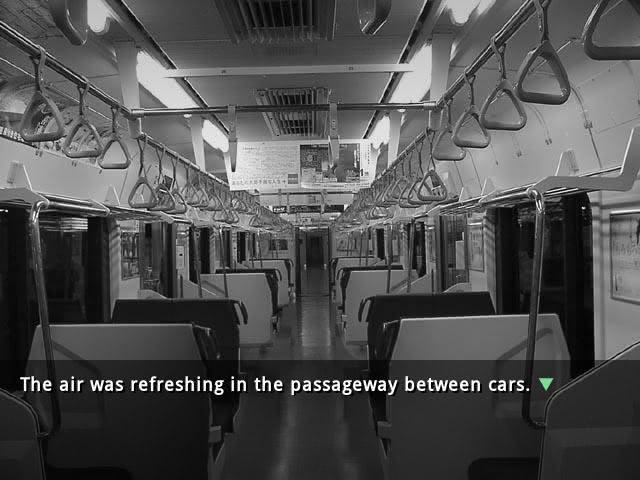
There are several points that make Until We Meet Again a striking visual production. Firstly, in nearly every visual novel that we have looked at – including modern commercial projects – characters stand apart from the backgrounds. In Until We Meet Again, the three characters (usually the woman and the girl because the game is told from the male protagonist’s perspective) are actually part of the environment. See a few examples below:


In Until We Meet Again, the characters actually sit in the chairs of the train, stand in the aisle, and converse. This, in turn, brings the photographic backgrounds to life.Moreover, although the character drawings are quite simple, Until We Meet Again gives the woman and the girl a variety of expressions and captures them from many angles.
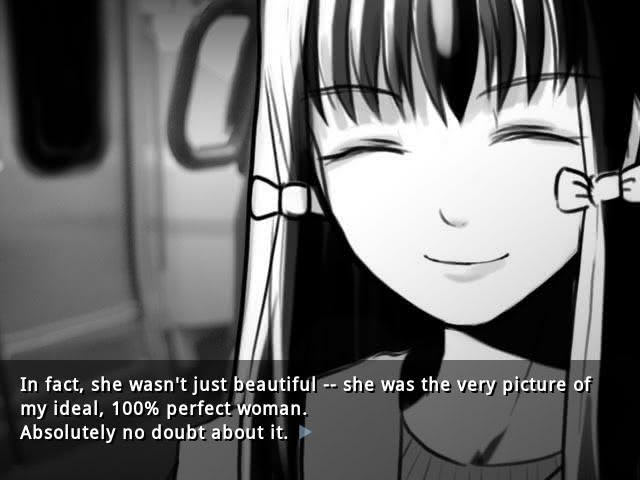
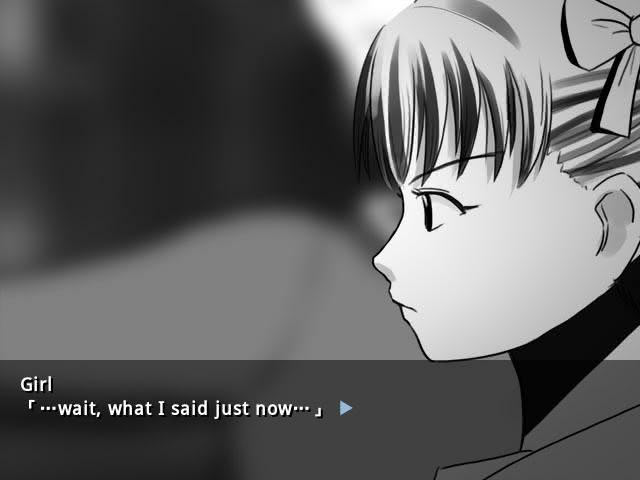
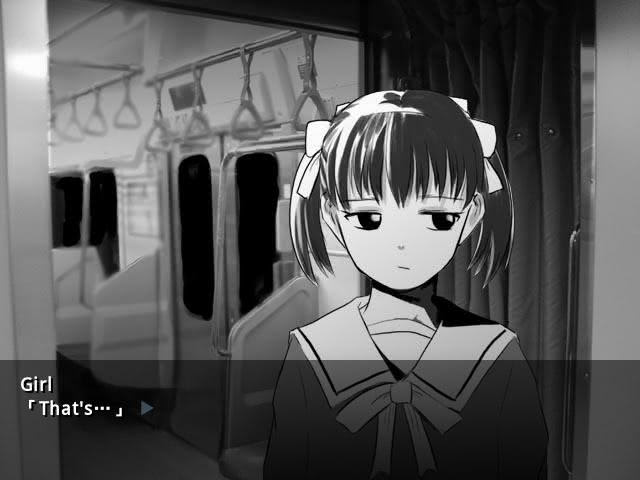
There are, however, a few issues in the art. For example, one cut that depicts the protagonist with his arm on the window sill looks a bit awkward. Some cuts of the woman character vary in quality.
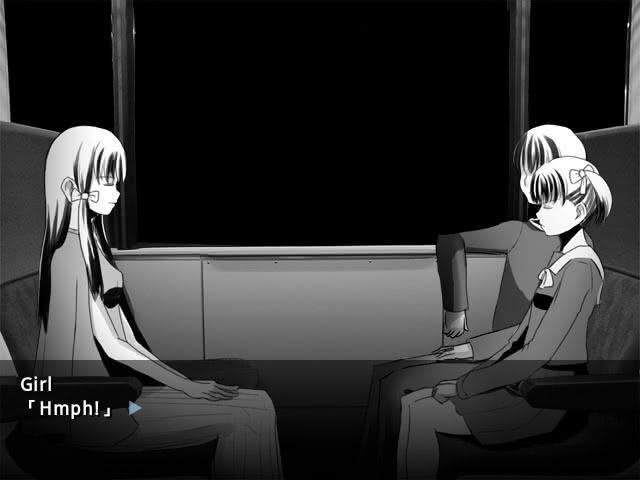
But the overall effect is very impressive – especially for a small indie project. Until We Meet Again depends heavily on setting a dreamy, uneasy ambiance, and it succeeds. The art style supports the story and themes well. It also possesses impressive attention to detail – the game itself offers a reason for why most of it is rendered in gray-scale.
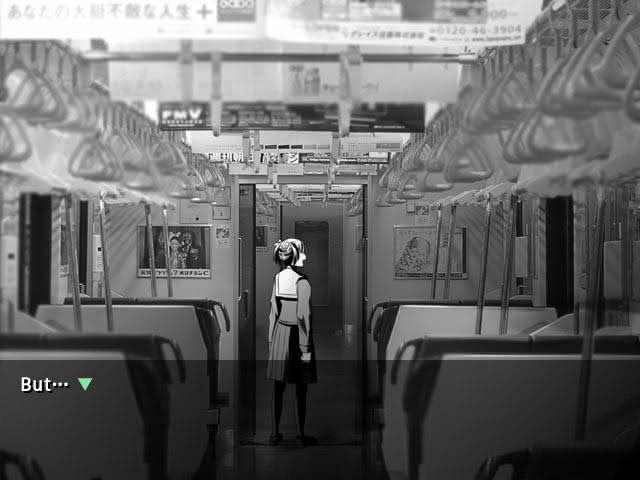
Before concluding, I will note that Until We Meet Again makes good use of transition effects – including both fade-away and static transitions.
On the whole, Until We Meet Again is not only one of the most visually striking al|together projects, its aesthetic is also attention-grabbing in a general sense. The style alone makes it worth reading.
Music
Like many other al|together-era freeware visual novels, Until We Meet Again used freely available music to make up its soundtrack. It chose its free music well, and all of the songs fit the theme – with the end-credits theme being the best of the lot. The list of songs is available in the game’s Readme file.
Until We Meet Again also features a few well-used sound-effects. The most prominent effect is the rumble of the train, which is used often but does not overwhelm anything. There is one scene with footsteps – and the footsteps are executed effectively.
Translation quality
Insani noted on Until We Meet Again’s al|together 2005 festival page that its translation was a quick effort:
On the localization end, this piece is probably most remarkable for the speed at which the translation project proceeded. Work on the translation began on 05 September 2005 12:00PM EST; the localization was released on 06 September 2005 3:00AM EST.
A 15 hour translation! Insani continued:
Perhaps this could be considered the first example of a visual novel ‘speedsub’, although the quality of the localization seems not to have suffered (much) from the urgent time-frame on which it was done.
Before continuing, note that I am only evaluating the translation based on how it reads in English. I cannot read Japanese, and thus cannot opine on how faithful the translation is to the original text.
The speedsub was completed principally by Mr. Seung Park, one of the leading figures at Insani. Unsurprisingly, it reads very well and conveyed some subtle sentiments from the three main characters. The writing was sensitive enough to credibly deliver the story’s emotional punch in the conclusion. There were 2-3 instances where I found something felt a little awkward – but the game reads excellently on the whole and, like most of Insani’s work, compares favorably to many commercial translations in terms of how it reads in English.
Writing and story quality
My overall impression of the quality of Until We Meet Again’s writing quality and story is positive, albeit the assessment comes with a few caveats.
Until We Meet Again, like the more famous visual novels created by Key, sets out to deliver an emotional punch (or, more bluntly, to reduce its paying customers to tears). It is clear from the very brief prologue prior to the protagonist awakening on a nearly-empty train that something sad had happened in his life. Moreover, the story effectively captures a certain unease about his situation even as he engages in a relatively pleasant enough conversation with the woman seated across from him. Even mildly astute readers will pick up that he should probably heed the cross words of the mysterious schoolgirl he bumps into a bit later in the story.
Until We Meet Again sets its strange little story up well and ultimately delivers its emotional punch at the end in a convincing way. While it is no Planetarian, it is ultimately a bit heartwarming.
Having noted my praise, I now explain why that praise is not unqualified.
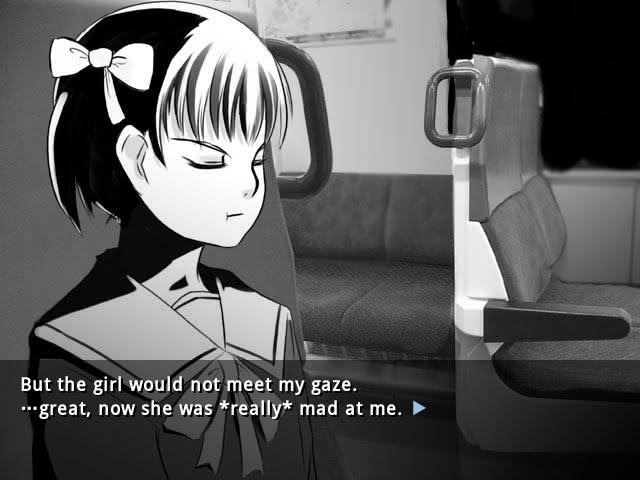
Firstly, Until We Meet Again is a touch too short to fully deliver on its promise. It uses its short run-time well to adequately explain the characters and their motivations as relevant to the conclusion, but there is not enough time to build the characters in such a way to make readers feel emotionally attached to them. This is a shortcoming for a work that plays and relies more on emotions than morals and high-minded themes. It also suffers a bit from its brevity in terms of a key point about the adult woman character which I will not spoil here. It should suffice to say that I do not think Until We Meet Again did enough work with respect to one aspect of her nature, and it would have been better served had it gone in a different direction in light of the limitations posed by its length.
Until We Meet Again does an effective job of telling a short, melancholy, but ultimately heartwarming story, but in this particular case, its short length and a couple of editorial choices held it back from being the best possible version of itself.
Technical points
Like all KiriKiri games, including modern ones, Until We Meet Again has a very Windows 98-esque menu bar. Here, you can create saves, load from saves, make the text advance automatically (and adjust the speed), and change the font.
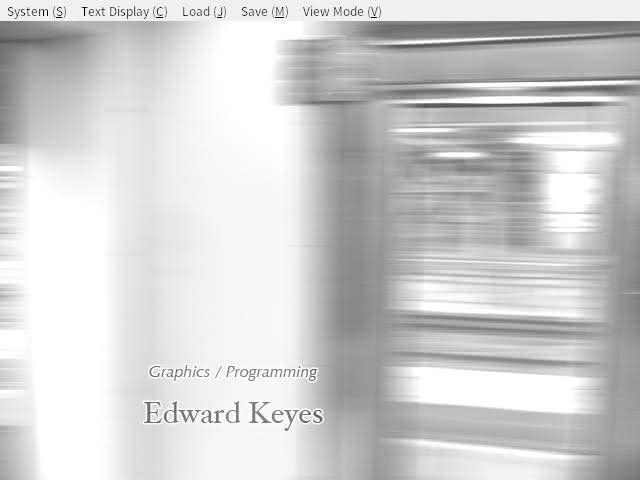
You can also read text history from the menu or with the scroll wheel:

I do have two technical issues to note. Bear in mind while reading that I ran Until We Meet Again on top of WINE on Linux, and your mileage with these issues may vary if you are running it on its native Windows.
Firstly, when I launched the game, there was a minor issue involving a few letters that dip (g, q, etc.) which were slightly cut off. I resolved the issue by going to “Text Display” on the menu and expressly selecting Microsoft Yahei – which was the only available font. Once I selected it, there were no text display issues.
Secondly, after the end credits concluded, the game did not return to the start. The only way to start a new game was to close the game and reopen it .
Final thoughts
Until We Meet Again is one of the better al|together visual novels I have read thus far. Its strongest point is its visual presentation, which is the most creative and effective of the novels I have read, and it is only rivaled by a few in terms of technical quality. Although the writing and story are not quite as notable as the visuals, Until We Meet Again is not let down by its short, understated, and emotional story.

Its precise ranking among the al|together visual novels will depend on what one values. For example, its story lacks the subtleties of From the Bottom of the Heart or the clear message of Red Shift, but for some, it striking visuals and mood combined with its own melancholy story may make up for any comparative deficiencies.
I recommend Until We Meet Again as a general matter – I think that its creative aesthetic is worth the free price of admission alone. and While this is one visual novel that would have benefited from being a touch longer, I found that its short length means that it does not overstay its welcome. The only caveat I attach to my general recommendation is that its demand for a Japanese runtime environment and a couple of other technical points that I noted make it a bit less accessible than most of the al|together translations.
(I also give it a special recommendation for train fans. It gets the train aesthetic just right.)
I recommend it as a must-read for anyone interested in visual novels as a general matter – Until We Meet Again is a shining example of a visually appealing and creative game created with very limited resources.
